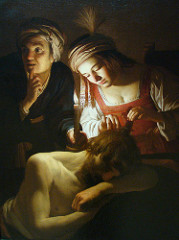
1.
1616. Honthorst. Rome
2.Patron: Unknown; most likely Marquis or Bourgese
3.
History Painting Book of Judges
didactic: teaches the viewer
Retold tons of Time
4. Judges
Rejected mannerism
2 changes: maid presence; she cuts his hair
Vices: avarice and lust
oil painting
12 year Truce in Rome
“To be in the lap of Delilah”
6. 4′
lifesized
thickly applied pain
loose in red area
7.Tenebrism
repousoir
Tans browns
source of light: candle
9.
Got the idea from Reubens 1609
10. Warning against prostitution
Pre feminist concept- me seduced by women
Women Empowerment
Comparisons:
Caravaggio:Judith 1598
Mantegna: Samson & Delilah 1419
van Leyden: S print before 1508
Artemeisa Gentileschi Judith and Her Maidservant
Rembrandt:The Blinding of Samsn
Patron: Grand Duke of Tuscany Medicci Family
Genre Painting
Comical Dinner Party
3 men 3 ladies old chrone
Light Source: Candle
Gluttany; Lust
Dangers of overindulging in the 5 senses: Vanitas Prints
Lute: sexual
Comparisons:
Karl van Mander (engraving after), Inn Scene, late16
Jan van Hemessen, Prodigal Son, 1536
Table Scene: Caravaggio, The Calling of St.
Matthew, c. 1597- 1601
Hieronymous Bosch, The Seven Mortal Sins, DET: Gluttony, 1475-80
Hendrick Goltzius( engraving after),Five Senses, c. 1595
Reduced version of The Merry Company
Lute: vagina
Genre counterpart of Samson and Delilah History Painting
Artificial lighting is the signature effect of Honthorst
Comparisons:
-Jan van Hemessen,Prodigal Son, 1530s’
-Caravaggio The Cardsharps. 1594
Fortune Teller 1595
-Honthorst Soldier and a Girl 1622
The Merry Fiddler, 1623
Avarice, 1624-34 (old woman and a coin)
1622. Utrecht
Prostitute holding lute, man holding coin “ready to go”
Day Scene-didn’t use candles
Appears in a Vermeer Painting “The Concert”
Trained under a different Mannerist
Comparisons:
-Dirck van Baburen, The Backgammon Players, c. 1624
-Boy with Jew’s Harp, c. 1621
Matthew
History from the Gospels
Utrecht was the center of Northern Catholicism
Daylit
working from a print
Source: Caravaggio
Conversion in Catholocism as a part of the Counter reformation
Mix contemportary and biblical garb
halfway figures; grotesque faces
table scene
Copies Caravaggio: Matthew bald, pointing at self; coins on the table; young boys; Men looking at money
Comparisons:
-Caravaggio, The Calling of St. Matthew, c.
1597-1601
-Jan van Hemessen, Calling of St. Matthew, c. 1535-40
-Saint Comparison:
Brugghen, St. Sebastian Attended by St.
Irene, 1621
compared to:
Caravaggio,
Deposition of Christ (Entombment), 1603-04
2 feet; Half Length, caught in the moment
Lively gesture of the boy
Flute: momento mori; vanitas; reminder of death
Blurring over eyes
simple background
daylit
browns and grays
Comparisons:
-Hals 5 senses roundels
-Ter Brugghen’s Pendants Fife and Flute Players 1621
-Caravaggio Lute Player 1596
-Steenwyck Vanitas Still Life 1645-50
-Hals The Merry Drinker, c. 1628-30.
-Hals Young Man and His “Sweetheart”, 1623
Early
*Frans Hals, Man Holding Skull, c.
1611
Frans Hals, Portrait of a Woman, c. 1611. (red dress)
MIddle
Frans Hals, Lucas de Clercq, c. 1635.
Frans Hals, Feyntje van Steenkiste, 1635.
Late
Frans Hals, Portrait of a Man in a Slouch Hat, c.1660-66.
Frans Hals, Portrait of a Seated Woman,c.
1660-66.
emphasis on Marriage
highest members of society
Earlier= Fijn (fine)
Later= Rouw (rough)
was a member of these “Police Forces”
Just the Officers- hung in a Doelen- Hung in the public room
Seemingly random action
only for officers who could pay
Ornamental Halberds
Comparisons:
-Frans Hals, St.
George Civic Guard Company, 1616
-Cornelis Anthonisz, Crossbowmen, “Banquet of the Copper Coin,” 1533.
-Frans Hals, Male Regents of the Old Men’s Almshouse, 1664
Shows figures as individuals rather than part of a group
Board of Directors
Hung in Different Rooms
20 shades of Black
Last stage before death
No interaction with eachother
Rouw style
30 total
Shows figures as individuals rather than part of a group
Board of Directors
Hung in Different Rooms
20 shades of Black
Last stage before death
No interaction with eachother
Rouw style
30 total
Judith Leyster 1630
30″
Picture within a picture Vanitas
Over the shoulder engaged with Viewer
She Painted musicians
Got married to an artist and had kids so she stopped
painted for 10 years
Comparisons
-Caterina van Hemessen, Self-Portrait, 1548
-Sofonisba Anguissola, Self-Portrait at the Easel, c.
1556. -Frans Hals, Willem Coymans, 1645.
-Judith Leyster, Two Children with a Cat, c. 1629.

1st singed and dated history painting
16′ wooden panel
Dutch Scholar: Petris Scrivarious
NT Acts only martyrdom in the Bible
Depicts Stephen as himself
Use of tennebrism and repusoir
Saul in the background
Comparisons:
Adam Elsheimer, Stoning of St. Stephen, 1603-04
Pieter-Pietersz Lastman, The Triumph of Sesostris, 1631

Both Painted and Etched
deep shadow reflected poor self image
1 of 41 different paintings of himself
use of butt of the brush for the hair in both
used needle and pen
Reused the copper from another etching
Love of old people
Comparisons:
Rembrandt, Self-Portrait, c. 1628-29
5′
Self portrait, History, and Genre that suggest the Prodigal Son: Peacock; Chalk Board with writing on it
Pride; Glutany; and Lust
Lute player in the background, but he was cut out
emphasis on silk and velvet
light seems to emanate from Saskia: his love
Comparisons:
-Gerrit van Honthorst, Merry Company, before 1620
-Gerrit van Honthorst, The Merry Fiddler, 1623.
-Frans Hals, Young Man and His “Sweetheart”,1623.
-Marten de Vos, Prodigal Son, 1604, etching.
-Title page from Contemporary Prodigal Son, 1630.
-Albrecht Dürer, Prodigal Son, c. 1496.
 The Anatomy Lesson of Dr. Tulp
The Anatomy Lesson of Dr. Tulp1632 Amsterdam
5’x7′
forshortening
portraiture
Comissioned
they are wearing their ruffs
Genre like-but not so
Book forces repusoir
body seems emanate light
some figures are engaging while others look out
unified triangle
hall of surgeons; guild of surgeons
interest in science
Tulp became mayor
Comparisons:
Regents of the Almshouse
St. Hadrian’s Gurard
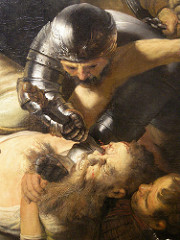
Rembrandt 1636
7’x5′
History Painting
International Dynamic Baroque
Judges
Lust and Avarice
Power of women
Monumentality
Gave it to the secretary to the President of the Dutch Republic: Constantine Huygens
Slashing diagonals and intense tenebrism
Comparisons:
Venician Influence from Titian, Samson and Delilah: Samson Taken Prisoner, 1540-45.
Van Honthorst: samson and delilah
Italian from Caravaggio: Martyrdom of St Matthew
Rivaled Peter Paul Rubens, The Capture of Samson, 1609-10.
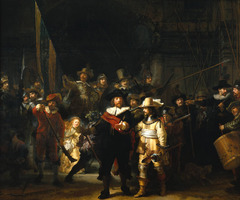
Musketeers=Kloveniers
Not really at night, called that at the end of the 18th century, after cleaning realized it was brighter
Triumphal arch: none in Amsterdam
Full length
shows 3 positions of Musketeers
painted himself into the back
Captain Cocq- forshortened hand
Liutenant in Yellow. Gorget around his neck
2 kids
Little Girl: light coming from her
holding a dead chicken:talons were on coat of arms as was yellow and blue (her clothes)
sense of hierarchy
18 paid, but included 13 more
Glazes:transparent and Impasto: layered on paint
Comparisons:
-Cornelis Anthonisz, Crossbowmen, “Banquet of the Copper Coin,” 1533
-Frans Hals, St. Hadrian Civic Guard Company, c.
1633.
-impasto: Titian, Death of Actaeon, 1565-76
8” etching
Berets were out of style
leisure, good looking, confident
twist of the body
Face is frontal not 3/4
body is almost completely profile
light filled space in blank area
Historicizing himself
Comparisons:
Raphael, Portrait of Baldassare Castiglione, after 1516.
Titian, Portrait of a Bearded Man, 1510-15
Rembrandt, Self-Portrait, 1640
Rembrandt, Self-Portrait Drawing at a Window, 2nd state, 1648
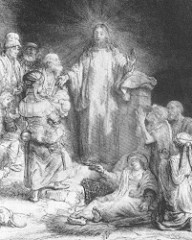
11″x15″
drop in commissions
death of his wife
History Print
Matt 19
Cinematic
bought it back for 100 guilders
used extra acid baths
extreme detail to just outlines
He only gave it to friends

Rembrandt 1654
5’square
Hendrickjie modeled
live in girlfriend
Venician Female nude
Historical painting
2 Samuel
Utrectian Tenebrism
Averice and Lust
Letter is tradtional
question of choice
she seems contemplatove
Coveting, Murder, and Adultery
Power of Women
Full body nude; realistic not ideal
Impasto
Comparisons: Tintoretto, Susanna and the Elders, c. 1555-56.
last commission ever
6′ by 9′
5 guild marshals and 1 servant
conversation and reacting to our presence
account book
forshortening of the table
angle from below
Picture with in a picture:seashore with a beacon with a fire: symbolism virtuous
United the marshals in catholic style
Chairmen of the the Board
Comparisons:
-Tulp
-Regents of the Almshouse
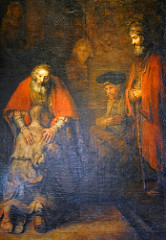
8.5′ tall
possibly unfinished
altarpiece style
not suitable for the alter
Protestant subject History Painting
Clothing of father suggest priest
“Praised Simplicity” -Pliny
not the popular scene to depict
light/dark contrast but not as intense as early stuff
lack of elegance
awkwardness
rouw
did a print in 1636 of same painting
Soft Tenebrism
Comparisons:
-Rembrandt van Rijn, The Conspiracy of Julius Civilis, c.
1661
-Domenichino, Last Communion of St. Jerome, 1614
Only selfie with him actually painting
Simple triangle
Life Size
Last Portrait
White hat
circles
emphasis on simplicity
use himself to wipe the brushes
could be an easel in the corner
impoverished
rouw
use of impasto
Comparisons:
All his other self portraits
Jusith Leyster





